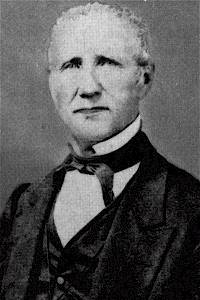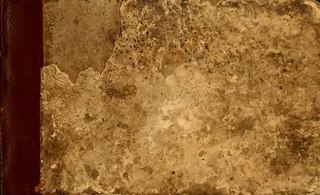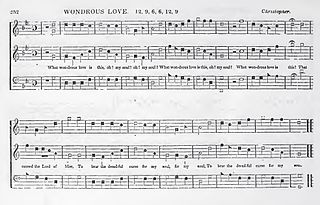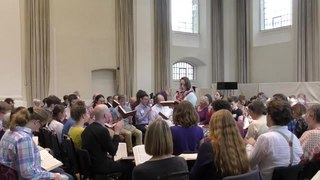Related Research Articles

Shape notes are a musical notation designed to facilitate congregational and social singing. The notation, introduced in late 18th century England, became a popular teaching device in American singing schools. Shapes were added to the noteheads in written music to help singers find pitches within major and minor scales without the use of more complex information found in key signatures on the staff.

Sacred Harp singing is a tradition of sacred choral music that originated in New England and was later perpetuated and carried on in the American South. The name is derived from The Sacred Harp, a ubiquitous and historically important tunebook printed in shape notes. The work was first published in 1844 and has reappeared in multiple editions ever since. Sacred Harp music represents one branch of an older tradition of American music that developed over the period 1770 to 1820 from roots in New England, with a significant, related development under the influence of "revival" services around the 1840s. This music was included in, and became profoundly associated with, books using the shape note style of notation popular in America in the 18th and early 19th centuries.

The Southern Harmony, and Musical Companion is a shape note hymn and tune book compiled by William Walker, first published in 1835. The book is notable for having originated or popularized several hymn tunes found in modern hymnals and shape note collections like The Sacred Harp.

William Walker was an American Baptist song leader, shape note "singing master", and compiler of four shape note tunebooks, most notable of which are the influential The Southern Harmony and The Christian Harmony, which has been in continuous use.

Benjamin Franklin White was a shape note "singing master", and compiler of the shape note tunebook known as The Sacred Harp. He was born near Cross Keys in Union County, South Carolina, the twelfth child of Robert and Mildred White.
Wilson Marion Cooper of Dothan, Alabama, was a notable musician and music teacher within the Sacred Harp tradition. Marion Cooper was born in Henry County, Alabama, the son of W. S. and Elizabeth Ann (Oates) Cooper. He was a cousin of Alabama governor William C. Oates.
James Landrum White was a shape note singing teacher, composer, and a reviser of his father's shape note tunebook known as The Sacred Harp.
Joseph Stephen James, of Douglasville, Georgia, was a lawyer, community leader, shape note singer, composer, and a reviser of the tunebook known as The Sacred Harp.
David Patillo White (1828–1903) was a shape note singing teacher, composer, and a co-issuer, with his father, of the 1870 Sacred Harp. He was the second child of Benjamin Franklin White and Thurza Melvina Golightly, whose other children were William Decatur, Robert H., Mary Caroline, Nancy Ogburn, Thurza Melvina, Benjamin Franklin, Jr., James Landrum, and Martha America.

Ananias Davisson was a singing school teacher, printer and compiler of shape note tunebooks. He is best known for his 1816 compilation Kentucky Harmony, which is the first Southern shape-note tunebook. According to musicologist George Pullen Jackson, Davisson's compilations are "pioneer repositories of a sort of song that the rural South really liked."

Sir Henry Rowley Bishop was an English composer. He is most famous for the songs "Home! Sweet Home!" and "Lo! Here the Gentle Lark." He was the composer or arranger of some 120 dramatic works, including 80 operas, light operas, cantatas, and ballets. Bishop was Knighted in 1842. Bishop worked for all the major theatres of London in his era – including the Royal Opera House at Covent Garden, the Theatre Royal, Drury Lane, Vauxhall Gardens and the Haymarket Theatre, and was Professor of Music at the universities of Edinburgh and Oxford. His second wife was the noted soprano Anna Bishop, who scandalised British society by leaving him and conducting an open liaison with the harpist Nicolas-Charles Bochsa until the latter's death in Sydney.
"The Parting Glass" is a Scottish traditional song, often sung at the end of a gathering of friends. It has also long been sung in Ireland, enjoying considerable popularity to this day and strongly influencing the style in which it is often now sung. It was purportedly the most popular parting song sung in Scotland before Robert Burns wrote "Auld Lang Syne".
The Sacred Harp is a shape note tunebook, originally compiled in 1844 by Benjamin Franklin White and Elisha J. King in Georgia and used to this day in revised form by Sacred Harp singers throughout America and overseas. This article is a historical overview and listing of the composers and poets who wrote the songs and texts of The Sacred Harp.

The Missouri Harmony, first published in 1820, was the most popular of all American frontier shape-note tune books during its reign. The 185 songs compiled in the collection were favorites used in Protestant churches and singing schools, and many were deeply rooted in American culture by the time of its first publication.
Aaron Williams (1731–1776) was a Welsh teacher, composer, and compiler of West Gallery music, active in Britain during the 18th century.

"What Wondrous Love Is This" is a Christian folk hymn from the American South. Its text was first published in 1811, during the Second Great Awakening, and its melody derived from a popular English ballad. Today it is a widely known hymn included in hymnals of many Christian denominations.

Sarah "Sally" Lancaster was an American composer in the Sacred Harp tradition. Three of her songs were published: "The Last Words of Copernicus", "I'm on My Journey Home", and "Sardis".
Judge J. Jackson was an American sacred harp composer, songwriter, and educator. His 1934 publication The Colored Sacred Harp was later recognized by scholars such as Doris Dyen and New Grove writer Joe Dan Boyd as an important document of early twentieth-century shape note singing practice.

John Wyeth (1770–1858) was a printer in Harrisburg, Pennsylvania who is best-known for printing Wyeth's Repository of Sacred Music, Part Second, which marks an important transition in American music. Like the original Repository of 1810, Part Second used the four-shape system of Little and Smith in The Easy Instructor to appeal to a wider audience; but its pioneering inclusion American folk tunes influenced all subsequent folk hymn, camp meeting, and shape note collections. Musicologist Warren Steel sees Wyeth's Repository of Sacred Music, Part Second as marking "the end of the age of New England composer-compilers (1770-1810) and the beginning of the age of southern collector-compilers (1816-1860)."

The Shenandoah Harmony is a 2013 republication of the works of Ananias Davisson (1780–1857) and other composers of his era, in the format used by modern shape note singing groups. Although a number of new shape note tune books were compiled and published in the two decades leading up to the publication of the Shenandoah Harmony, this volume is notable as "the largest new four-shape tunebook published for more than 150 years." The importance of the Shenandoah Valley for the emergence of a distinctive Southern shape-note singing tradition has been noted by many musicologists. Authentic South reporter Kelley Libby of WFAE, attending an all-day singing in Cross Keys, felt "transported to the Shenandoah Valley of the 1800s."
References
- Steel, David Warren (with Richard H. Hulan) (2010) The Makers of the Sacred Harp. Urbana: University of Illinois Press.